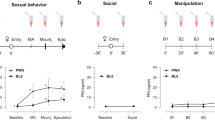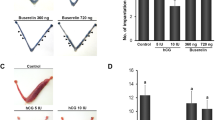Abstract
ON the basis of results obtained with testosterone administered, together with pregnant mare serum gonadotrophin, to anœstrous ewes Cole1 suggested that androgen may be responsible for the induction of œstrous behaviour in the sheep. Robinson2, however, has shown that œstrogen given following a period of progesterone priming will induce both behavioural and vaginal œstrus in spayed ewes, and it is probable that normal cyclic œstrous behaviour is due to an interaction of these two hormones. In the course of work on the interaction of several steroid hormones on behavioural and vaginal œstrus in spayed ewes, a preliminary trial showed that a single dose of testosterone or of testosterone propionate resulted in mating behaviour in a number of animals. Consequently, a factorial design test, using 72 spayed ewes, was conducted to examine this phenomenon and to define the nature of the apparent œstrous response. The variables introduced (with n = 12) were priming treatment (no progesterone or 10 mgm. per day for 12 days)3, and dose of androgen (1.0, 3.2 or 10.0 mgm.). The androgen was testosterone propionate. Sexual receptivity of the ewes was determined using 8 intact rams fitted with ‘Sire-sine’ harnesses and crayons4 and the vaginal response was determined by smears taken for four days following injection of androgen5. Results are presented in Table 1.
This is a preview of subscription content, access via your institution
Access options
Subscribe to this journal
Receive 51 print issues and online access
$199.00 per year
only $3.90 per issue
Buy this article
- Purchase on Springer Link
- Instant access to full article PDF
Prices may be subject to local taxes which are calculated during checkout
Similar content being viewed by others
References
Cole, H. H., Western J. Surg., Obstet. and Gynecol., 56, 503 (1948). Cole, H. H., Hart, G. H., and Miller, R. F., Endocrinol., 36, 370, 1945.
Robinson, T. J., Endocrinol., 55, 403 (1954).
Robinson, T. J., J. Endocrinol., 12, 163 (1955). Robinson, T. J., Moore, N. W., and Binet, F. E., J. Endocrinol., 14, 1 (1956).
Radford, H. M., Watson, R. H., and Wood, G. F., Austral. Vet. J., 36, 57 (1960).
Robinson, T. J., and Moore, N. W., J. Endocrinol., 14, 2 (1956).
Robinson, T. J., and Reardon, T. F., J. Endocrinol. (in the press).
Salmon, U. J., and Geist, S. H., J. Endocrinol., 3, 235 (1943).
Dorfman, R. I., and Shipley, R. A., Androgens, Biochemistry, Physiology and Clinical Significance (John Wiley and Sons, New York, 1956). Zander, J. J., Biol. Chem., 232, 117 (1958). Kase, M., Fochielli, B., and Dorfman, R. I., Acta Endocrinol., 37, 19 (1961).
Author information
Authors and Affiliations
Rights and permissions
About this article
Cite this article
LINDSAY, D., ROBINSON, T. Œstrus-inducing Activity of Testosterone in the Ewe. Nature 192, 761–762 (1961). https://doi.org/10.1038/192761a0
Issue Date:
DOI: https://doi.org/10.1038/192761a0
This article is cited by
-
Plasma levels of luteinizing hormone, estradiol and androstenedione in sows with inadequate plasma progesterone
Journal of Endocrinological Investigation (1983)
-
Urinary Excretion of Oestrone and Oestradiol and of Zimmermann Chromogens in the Sow During Oestrus
Acta Veterinaria Scandinavica (1965)
Comments
By submitting a comment you agree to abide by our Terms and Community Guidelines. If you find something abusive or that does not comply with our terms or guidelines please flag it as inappropriate.



